Holme Sluice Fish Pass Phase 2 (2024)
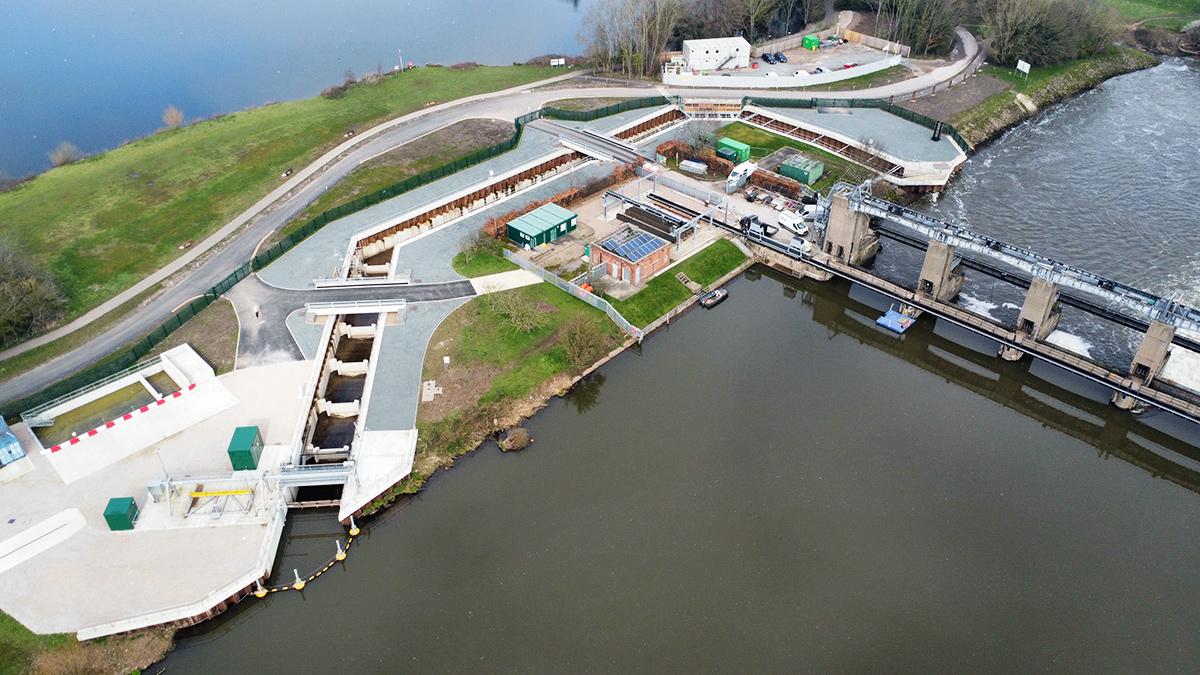
The completed Holme Sluice fish pass - Courtesy of Jackson Civil Engineering Ltd
Starting on site in 2022, the conceived project was to construct a new fish passage around the Holme Sluice Gates on the River Trent, allowing bi-directional travel of all breeds of fish from salmon to coarse river fish. The existing gates were constructed in the 1950s and are currently operated by the Environment Agency to maintain navigable river levels within the Nottingham area.
This paper follows up on one published by Water Projects in 2022, and looks at the construction and commissioning elements of the project.
Background
When the Holme Sluice Gates structure was constructed, the River Trent was diverted from its original path around the Country Park through a newly excavated 80m wide cut channel. At the side of the sluice gates is the Holme Canal Lock with a further adjacent water structure of the Holme Pierrepont canoe slalom course; all of which create barriers for migratory fish back up the River Trent.
Project summary
As the sluice gates will remain in operation, the fish pass channel requires two bridges rated to 40t to be built to maintain access to that area. The channel is to be protected at the intake via a single floating boom and the water isolated from the channel by a combination of removable stop logs and an automated radial gate system.
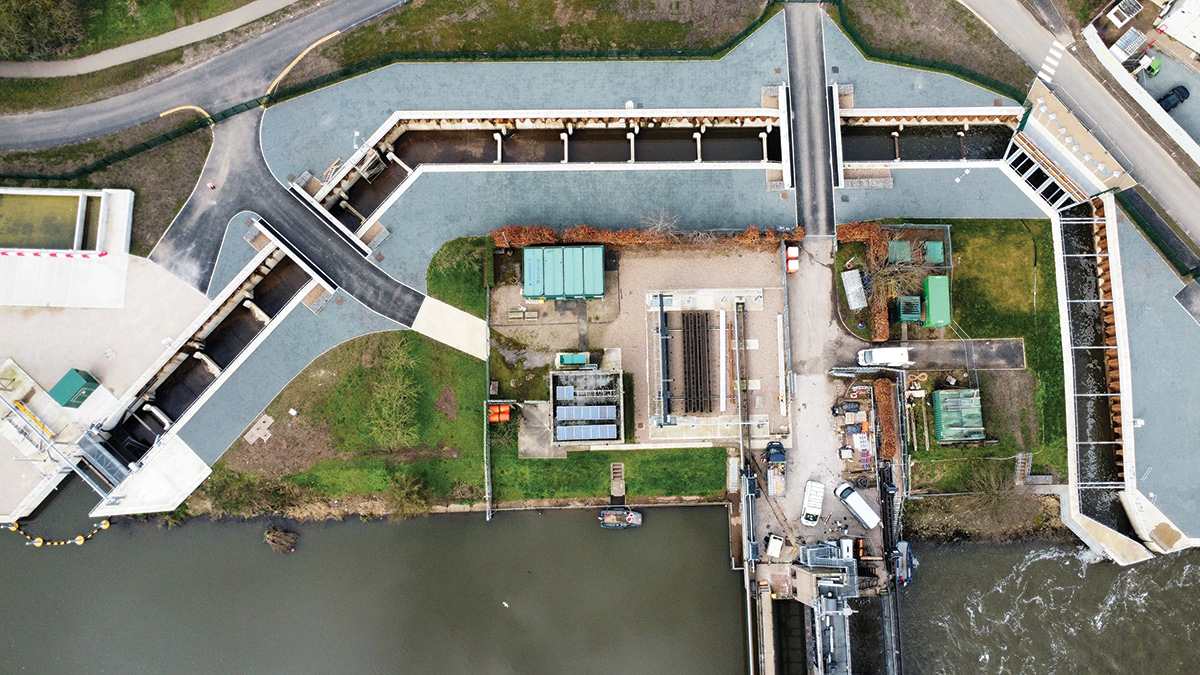
Aerial view of the completed fish pass – Courtesy of Jackson Civil Engineering Ltd
The design of the fish pass has been provided by the Environment Agency’s designer, TEAM Van Oord (TVO), with Jackson Civil Engineering Ltd (JCE) undertaking design elements for the temporary works and the Mechanical, Electrical, Instrumentation, Control and Automation (MEICA) elements.
The fish pass design has a total flow rate of 4.4m3/s – 4.9m3/s with a varying water depth of 1.5m- 1.7m. Although the velocities within the vertical slots have a flow rate of 2m3/s, the pools created at each stanchion bay slows this to >1m3/s; allowing fish to rest as they travel through the pass.
Where we left off……
This paper follows on from an initial case study published by Water Projects in August 2022. In the time since, the piling works (which started in April 2022) were completed by Ivor King The Piling People, following a period of ground pre-auguring to ensure that the circa 10m AZ700-36 sheet piles could be driven with relative ease.
A total of 350 sheet pile pairs with a number of singular piles were driven into the ground to produce the working cofferdam.
Due to the inlet and outlet elements of the fish pass having to be installed within the river flow, it was imperative that the works hit the allowable in-river works period to avoid damage to spawning fish and suitable breeding grounds. This period ran from 15 June 2022 to 2 October 2022; these dates forming an X5 Contract Key Date. Work on the inlet/outlet sections started nine workdays after the period started, and all piling works were completed by the end of August 2022.
There were some significant challenges throughout this period, the depth and complexity of excavating safety behind the sheet wall to install tie piles at a depth of 4-5m requiring a significant portion of the river bank (50m3) to be removed stored and reinstalled and for a number of the tie bar being at a level below the surface of the river, meant a design change was needed to a welded beam solution on the backside of the piles.
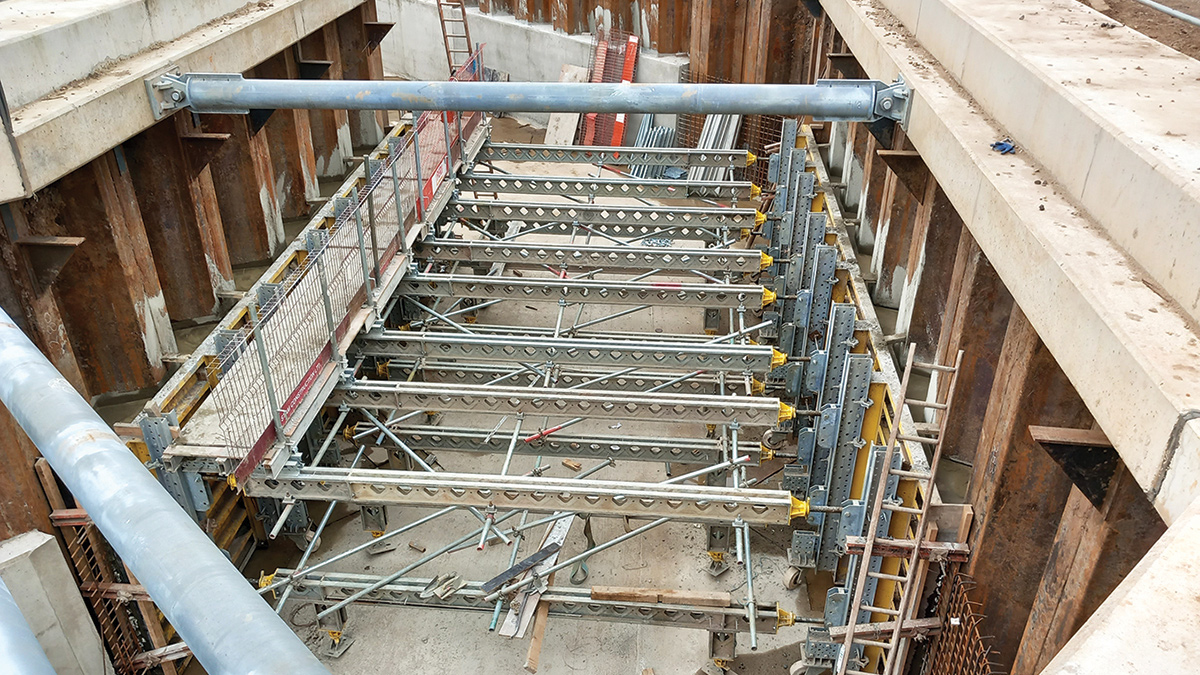
Modular wall shuttering in place for wall pour – Courtesy of Jackson Civil Engineering Ltd
Channel design concept
In summary, the channel concept included a full height channel wall at the inlet and outlet, joined on both sides by a 2m high dwarf FRC sheet pile wall. Around the top of the sheet piles, a non-structural concrete pile capping beam (chainage 24m – 150m) was required, at which point the design changed to a structural capping beam.
This design was driven by the ground pressures seen on the sheet pile walls in that the channel floor would act as the only prop needed in the non-structural sections, however, due to the increasing depth of the channel towards the discharge end the top of the channel would also need to be permanently propped as well as using the base slab.
The start of earthworks & FRC
Originally the staging for construction was to temporarily prop the sheets at the top throughout the channel run, excavate down to design invert level, cast the base slab and the install the capping beams. This would require the need for significant soffit support systems and working at height.
Through detailed project discussions with the principal designers and supply chain, the decision was made to excavate only the area needed for the capping beam and use the ground formation to act as the soffit support there for removing a significant health and safety risk. To allow access throughout the construction period a section of capping beam was left out (5m of the 400m required) which would require a conventional support system for install.
Earth removal started in earnest in mid-August 2022 reducing the ground to install 26 (No.) SBS 400-185Hyd struts and 300m linear lengths of SSB wailing beams provided by Mabey Hire Ltd.
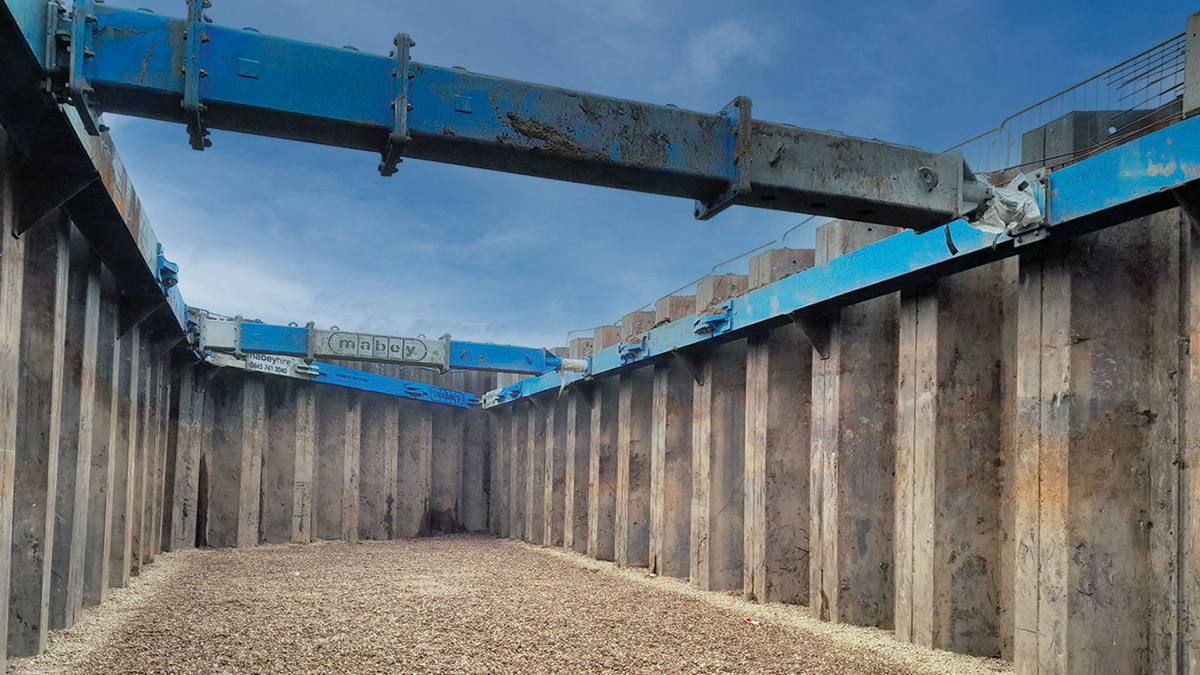
Excavated fish pass awaiting FRC works – Courtesy of Jackson Civil Engineering Ltd
Groundwater challenges
From the provided geotechnical report it was noted that groundwater was expected circa 2m below the ground surface and from engaging with a dewater drainage specialist it was possible that installing a dewatering system would require a significant number of well points discharging 25 l/s. The larger issue was that these wells would need to be installed through the capping beam (not aesthetically pleasing) or would be placed in the way of the bulk earthworks removal.
A number of trail pits were excavated to 4m to assess the realistic nature of the groundwater. Little groundwater was evidenced during these tests, therefore the project proceeded without the use of dewatering, with a mitigation measure that a local sump would be created to allow groundwater to be pumped our using a 6” end suction over pump, to aid in the drainage and working surface a 100mm thick layer of gravel (350 tonnes) was installed in the bottom of the channel to allow the water to flow beneath and work plant. The risk of significant groundwater did not materialise.
The installation of the temporary struts and excavation of bulk material were done in sections therefore allowing manoeuvrability of the excavator to reach between the piles. M2 Civils Ltd, the earthworks contractor, removed on average 24 road wagons of earth per day, totalling 1458 loads or 27,935 tonnes (13,760m3).
Holme Sluice Fish Pass: Supply chain – key participants
- Client designers: Team Van Oord
- Principal contractor: Jackson Civil Engineering Ltd
- Temporary works design: Waterman Group
- Mechanical design: KGAL Consulting Engineers Ltd
- FRC: STAM Construction Ltd
- Groundworks: M2 Civils Ltd
- Piling works: Ivor King The Piling People
- River works: Red7 Inshore Diving
- Ground support: Mabey Hire Ltd
- Electrical design & control equipment: IMAC Ltd
- Radial gate system & stop logs: Centregreat Engineering Ltd
- Eel tiles: Berry & Escott Engineering Services
- Fish monitors: FishTrack
- Precast concrete beams: Banagher Precast Concrete Ltd
- Tarmac & surfacing: CR McDonald Surfacing
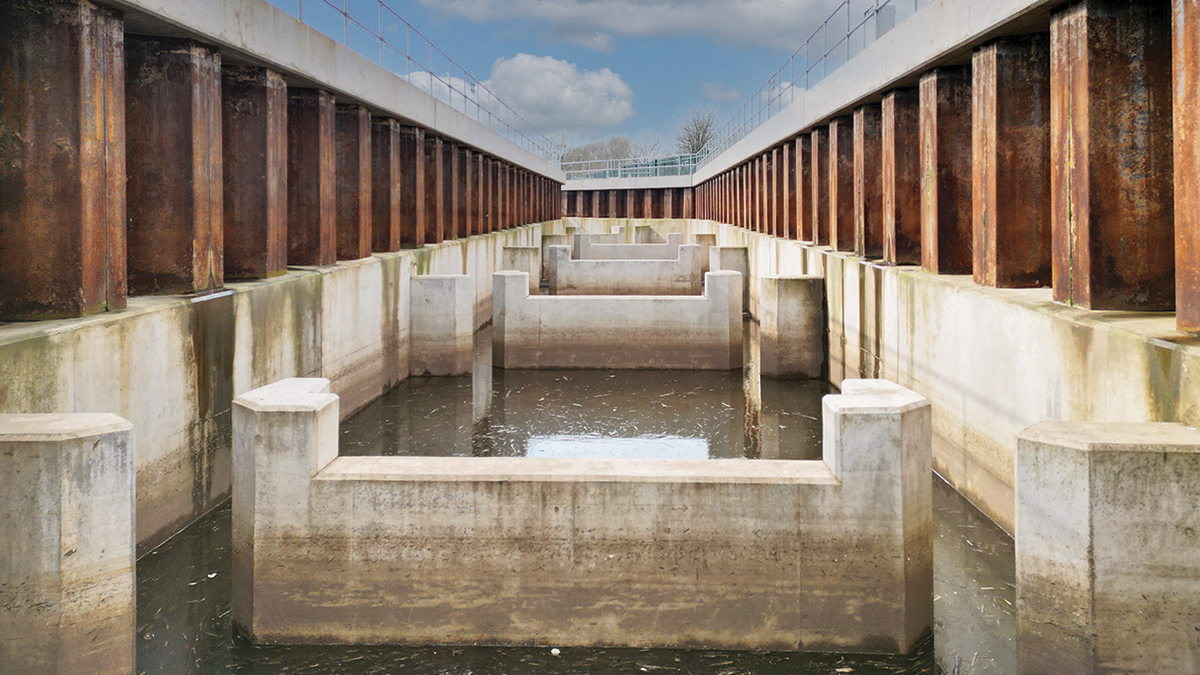
Non running fish pass mid-distance – Courtesy of Jackson Civil Engineering Ltd
FRC
The FRC works was undertaken by STAM Construction Ltd and started in October 2023 with the installation of base slab using cut and bent reinforcement steel throughout the construction. This would then allow the high-level shoring props and wailing beams to be removed. Due to the nature of the design being effectively three straight runs of dwarf walls, the wall shuttering system (9m long by 2.5m high) was constructed on an adjustable wheeled cart, thus allowing the shutters to be installed, retracted, moved, and redeployed reducing the use of timber and removing significant lifting and manual handling risks.
To facilitate this the project teams worked on providing a solution to allow the shuttering system to fly past the starter bars required for the wall and floor stanchions. This was achieved by utilising a ‘Startabar’ product whereby the RC bars are encased under a steel cover which is then removed, and the bars bent out to the correct position after the wall concrete has been poured.
To construct the wall and floor stanchions, conventional shuttering systems were employed. In total 329 tons of steel reinforcement was used and 2,250m3 of concrete were pumped.
Bridges
The construction of the fish pass has created an island of the operational sluice gates requiring 24 hour. To service this asset, two permanent 40T rated road bridges were designed and installed. A major project challenge was to sequence the bridge construction start for after the bulk excavation had past the bridge locations and have them finished before the temporary access created across the sheet piles needed to be excavated out. This includes the bridge abutments, deck and on/off ramps. The bridge construction utilised MY3/MY3E precast concrete beams spanning 12.6m utilising seven beams per bridge and used scaffold soffit support system to all for cast in situ sidings and deck. The MY3 beams were planned and delivered in a ‘Just in Time’ strategy allowing a direct lift and install from the wagon to their installation location.
Construction started September 2022 and finished October 2022 including the installation of the vehicle restraint system, notably the bulk earth movement completed by removing the temporary access to the island in December 2022.
MEICA
The water passage through the pass is controlled by an automated radial gate system, using local river levels and area flow gauges. The gate opens when the flow is greater than 49m3 and the level is above 20.34m AOD; should either of these readings become false the gate will close.
The gate spans the full width of the channel with a radius of 3.5m and stands closed at a vertical height of 1.9m. Using a single actuator the gate (10 ton self-weight) is lifted and lowered via a steel cable winch system with a full extent of travel being circa 4m vertically.
The radial gate solution was chosen by the designers as the best suitable control mechanism due to the following benefits:
- Requiring less infrastructure than a vertical gate (no need for structures/lifting frame/gantry above the channel) all reducing the civil reinforcement design in those areas.
- Less energy to operate as loads are transferred through the pivots and the geometry of the gate means upwards water pressure will assist with lifting.
- Longevity of the seals as loads transferred through the pivots and not into guides and seals.
- No need for channels/slots in the walls/base of the channel which could become blocked with debris and would also affect hydraulics.
Even though the size of the fish pass requires significant volume of water to achieve a steady state, this is realised in approximately 90 seconds from the start of the gate opening even though the gate takes 8 minutes to fully clear the pass/river surface.
The isolation of the fish pass for maintenance purposes is undertaken by the installation of five 6.8m long stop logs. These are deployed using an 18m long lifting gantry with dual lifting hoist with a SWL of 2.5T and a hand cranked moveable storage cart.
While the pass is in operation there will be free bidirectional passage for aquatic life, however during non-operational periods eels are still likely to try and pass and with the water during non-operational period only filling the last third of the pass, there is the potential for the eels to become stranded in the pass. Therefore, the pass has been designed with eel chute compliant with the Eels Regulations 2009. The chute and subsequent rebates along the edges of the pass have been fitted with fixed plastic eel tiles therefore providing purchase to aid the eels in their journey. To assist the chute, which is connected to the radial gate and is lifted out of the water during gate operation, while the gate is closed there is a constant flow of water covering the eel tiles guided by the fall of the channel base and surface mounted fixed plastic lumber sections.
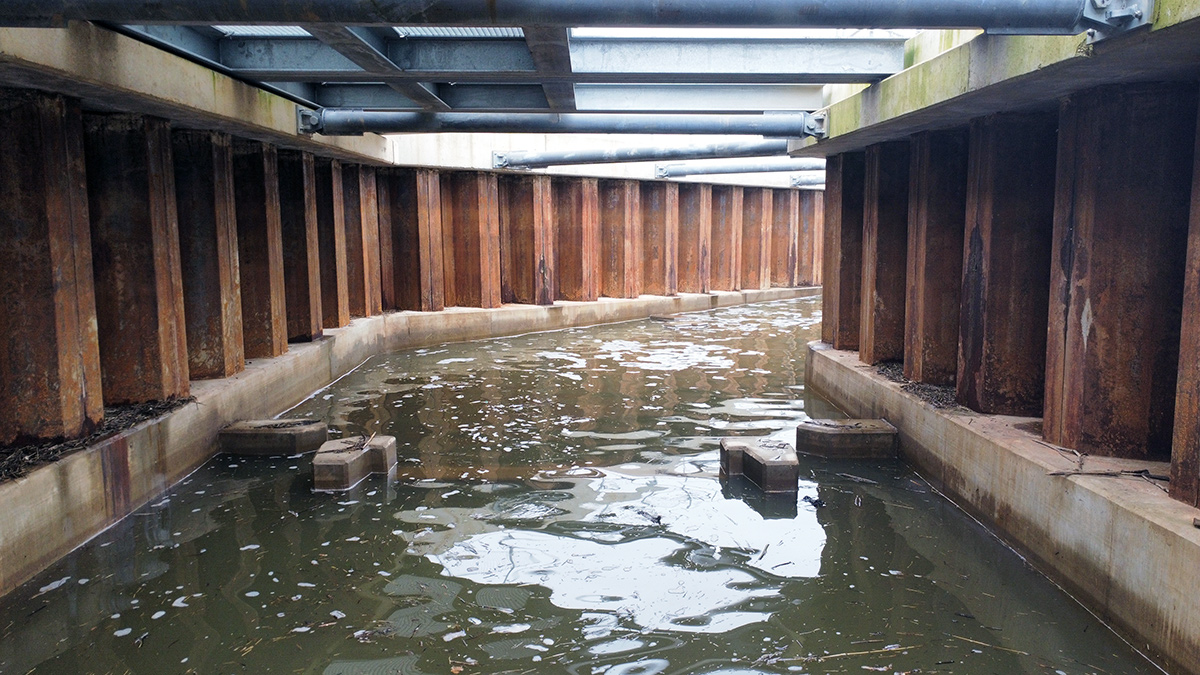
Completed fish pass – Courtesy of Jackson Civil Engineering Ltd
Pass/river interfaces
Extensive riverbank and river bend modifications were needed to ensure that the pass joined and exited the river and was engineered to prevent erosion. During the in-river works period of 2022 and detailed as a key date within the contract, specialist dive services were employed to dredge out the riverbank/bed and place 80-100T of scour protection amour using 5-300kg sections of rock.
This was all achieved using bank-side long reach excavators; therefore being more environmentally friendly, with greater efficiency than deployment of float pontoon platforms.
Due to the in-river works, stringent protection measures were placed on the project with regards to fish protection and silt migration. The project team deployed 100m of silt bubble curtains around the river work areas to reduce the any sit mitigation as well as undertaking on-site water quality monitoring for turbidity and dissolved oxygen both upstream and downstream, and within the works area. Data showed that the work area was a factor of 10 higher than the up/downstream areas, which remained within agreed permissible limits.
Further dive works included underwater cutting and removal of the cofferdam end sections to open the fish pass to the river. This solution was chosen as it reduced the risk of delays and damage to permanent structures during a vibration extraction method.
Monitoring fish usage
The fish pass is fitted with state of the art near-field communication hardware (passive induction transmitters) to facilitate the monitoring of fish passage. When the electronics are installed, the system will allow the client to understand how effective the pass is, the direction of fish travel and time spent within the pass.
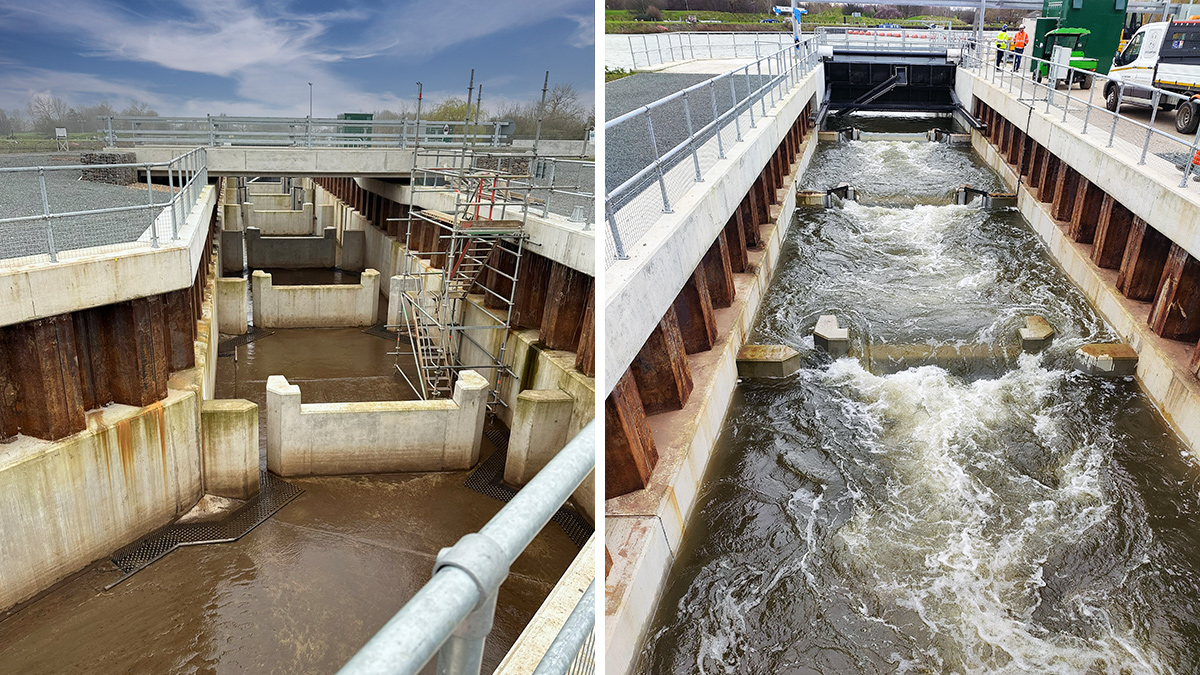
(left) Completed fish pass looking towards the intake structure and (right) fish pass in operation showing control radial gate – Courtesy of Jackson Civil Engineering Ltd
Conclusion
The project completed on 14 May 2024 having run for 27 months. The following is a statement from Simon Ward, Fisheries Specialist with the Environment Agency.
“After two years in construction, and several years of planning and design, the Colwick (Holme Sluices) Fish Pass on the River Trent is now complete and ready for fish to use enabling them to reach their spawning and feeding grounds. This flagship project opens up the River Trent and its tributaries for migratory fish, including salmon, trout and eels, making more habitat accessible for fish. Whilst a complex task the construction ran smoothly throughout and the partnership of designer, constructor and EA Fisheries technical staff working together is an exemplar of what can be achieved for the environment.
“The fish pass is part of the Environment Agency’s work to improve fish passage across the country and provides a significant step in restoring the River Trent catchment to its former glory for salmon and other coarse and migratory fish. The project also includes an eel pass to help support the critically endangered European eel; and a public viewing platform above the water, with highly visual interpretation boards to inform and advise visitors about the local wildlife in and around the river, including the fish that are expected to use the pass.”
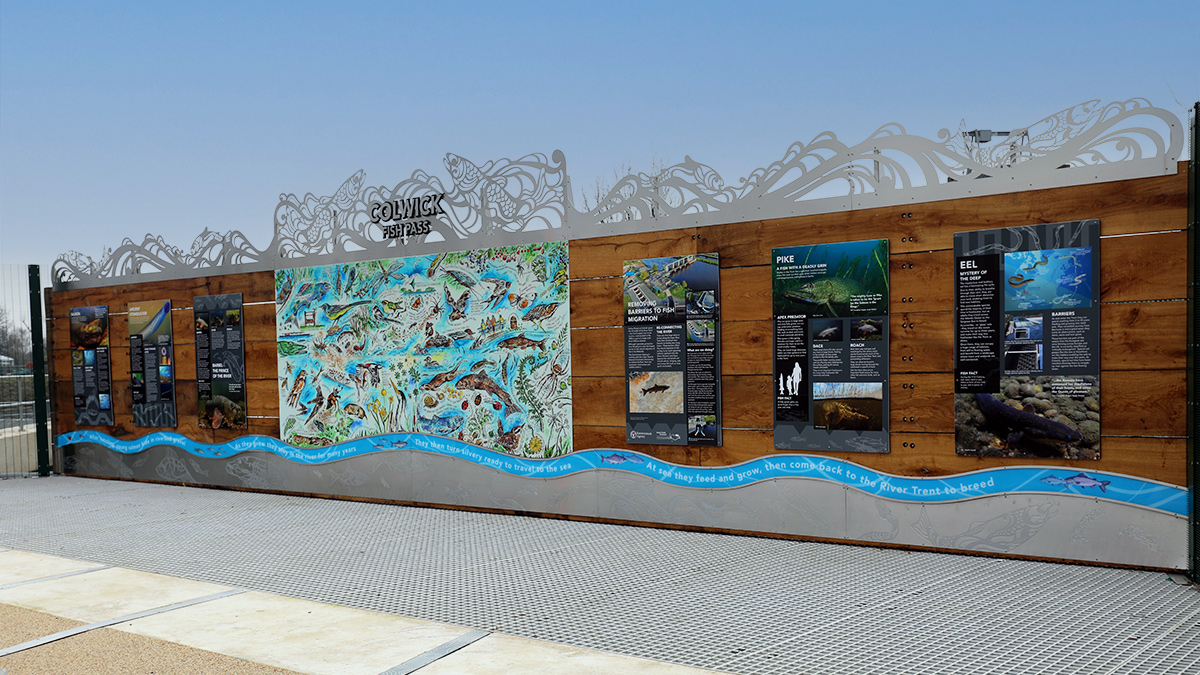
Completed public viewing platform - Courtesy of Jackson Civil Engineering Ltd





